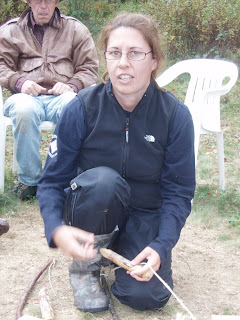Where there's smoke, there's fire (sometimes!)
fire (sometimes!)







Simply Surviving
After a brief review of the basic concepts of emergency survival, compass use and sun location, team members built snares designed to catch small mammals. A pine sapling was used to power the snare and a twine catch loop was set in the center of a known animal trail. A snare of this size and type would be effective in catching raccoons, porcupines, rabbits, hares and skunks. Although skunks would clearly be an inadvisable dinner choice!
Cooking dinner posed a new problem. How to start a fire? Fire by friction was the choice. Team members constructed a bow and spindle. The bow was used to rapidly turn the spindle, generating enough friction to cause the tip of the spindle to become red hot and ignite some birch tinder. Due to a light rain, we were unable to ignite the tinder, but team members did generate enough heat to produce smoke.
After a brief review of the basic concepts of emergency survival, compass use and sun location, team members built snares designed to catch small mammals. A pine sapling was used to power the snare and a twine catch loop was set in the center of a known animal trail. A snare of this size and type would be effective in catching raccoons, porcupines, rabbits, hares and skunks. Although skunks would clearly be an inadvisable dinner choice!
Cooking dinner posed a new problem. How to start a fire? Fire by friction was the choice. Team members constructed a bow and spindle. The bow was used to rapidly turn the spindle, generating enough friction to cause the tip of the spindle to become red hot and ignite some birch tinder. Due to a light rain, we were unable to ignite the tinder, but team members did generate enough heat to produce smoke.
No comments:
Post a Comment